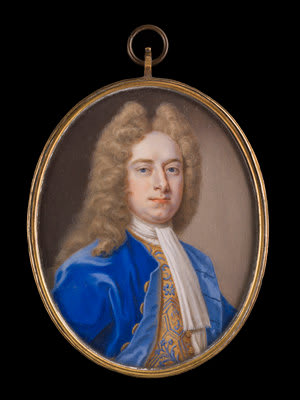
Christian Richter
Portrait miniature of Gentleman, probably Robert Cholmeley (d. 1754), wearing a blue coat and waistcoat decorated with a foliate pattern, early 18th century
Watercolour on vellum
Oval, 3 in (77 mm) high
Philip Mould & Co.
To view all current artworks for sale visit philipmould.com Richter was born into a family of artists in Stockholm, Sweden in 1678, the son of Hans Davidson Richter, assessor...
To view all current artworks for sale visit philipmould.com
Richter was born into a family of artists in Stockholm, Sweden in 1678, the son of Hans Davidson Richter, assessor of the Goldsmith’s corporation there, and brother of landscape painter Johann Richter and the medallist Bengst Richter. Richter quickly found his feet, learning initially the goldsmith craft followed by medal engraving under Arvid Karlsteen. By 1700 Richter is believed to have been studying under Elias Brenner, the leading Swedish miniaturist of the age. Richter soon proceeded to Berlin then Dresden, seeking patronage by utilising contacts from previous acquaintances. Arriving in London in 1704, he quickly established himself as a miniaturist, cleverly seizing the opportunity to replicate the work of contemporaries such as Hans Hysing and Michael Dahl, who would have been eager to expand their own reputation. We can gather through Vertue’s notebooks that Richter and Dahl developed an emphatic bond- most likely due to their shared native land, and the latter; “…encouraged him & promoted him all he cou’d by which means he became really an excellent Master…really better than any of his contemporaries”[1]
Soon after 1715 however, Richter developed a terrible illness which left him with facial disfiguration, and he began to be increasingly withdrawn. No longer feeling capable to paint from life, Richter took to concentrating on replicas of portraits by the prominent painters of the day.
This portrait of a gentleman of the Leigh-Perrott family was evidently drawn from life. The careful observation of the turned back lapels and shadow cast on the sitter’s waistcoat by his white silk jabot demonstrate a high level of skill.
The sitter is probably Robert Cholmeley (d.1754), father of Jane Leigh-Perrot (nee Cholmeley), and aunt of the English author Jane Austen (1775-1817). The Cholmeley family were prosperous, Robert Cholmeley’s brother, Montague Cholmeley, 1st Bt. of Easton (1772-1831), was an MP for Grantham and resided at Easton Hall, Lincolnshire. Robert held large amounts of land in Barbados, which is where Jane was born before being sent to England for education. On 9th October 1764 Jane married James Leigh-Perrot who was the brother of Jane Austen’s mother Casssandra Leigh, although choosing to add ‘Perrot’ to his name in 1751 in order to inherit the estate of his maternal great-uncle, Thomas Perrot. Jane Leigh-Perrot and her husband were very supportive of the young Jane Austen, and although she found her at times ‘an overbearing and condescending woman’ [4], her financial assistance and influence no doubt aided the authors rise to prominence.
[1] Vertue, Note Books. 3.25.
[2] Vertue, Note Books. 3.76.
[3] Schidlof. The Miniature in Europe. Vol.2. p.675.
[4] Angelika Beck, Jane Austen, 1995 p.g.84.
Richter was born into a family of artists in Stockholm, Sweden in 1678, the son of Hans Davidson Richter, assessor of the Goldsmith’s corporation there, and brother of landscape painter Johann Richter and the medallist Bengst Richter. Richter quickly found his feet, learning initially the goldsmith craft followed by medal engraving under Arvid Karlsteen. By 1700 Richter is believed to have been studying under Elias Brenner, the leading Swedish miniaturist of the age. Richter soon proceeded to Berlin then Dresden, seeking patronage by utilising contacts from previous acquaintances. Arriving in London in 1704, he quickly established himself as a miniaturist, cleverly seizing the opportunity to replicate the work of contemporaries such as Hans Hysing and Michael Dahl, who would have been eager to expand their own reputation. We can gather through Vertue’s notebooks that Richter and Dahl developed an emphatic bond- most likely due to their shared native land, and the latter; “…encouraged him & promoted him all he cou’d by which means he became really an excellent Master…really better than any of his contemporaries”[1]
Soon after 1715 however, Richter developed a terrible illness which left him with facial disfiguration, and he began to be increasingly withdrawn. No longer feeling capable to paint from life, Richter took to concentrating on replicas of portraits by the prominent painters of the day.
This portrait of a gentleman of the Leigh-Perrott family was evidently drawn from life. The careful observation of the turned back lapels and shadow cast on the sitter’s waistcoat by his white silk jabot demonstrate a high level of skill.
The sitter is probably Robert Cholmeley (d.1754), father of Jane Leigh-Perrot (nee Cholmeley), and aunt of the English author Jane Austen (1775-1817). The Cholmeley family were prosperous, Robert Cholmeley’s brother, Montague Cholmeley, 1st Bt. of Easton (1772-1831), was an MP for Grantham and resided at Easton Hall, Lincolnshire. Robert held large amounts of land in Barbados, which is where Jane was born before being sent to England for education. On 9th October 1764 Jane married James Leigh-Perrot who was the brother of Jane Austen’s mother Casssandra Leigh, although choosing to add ‘Perrot’ to his name in 1751 in order to inherit the estate of his maternal great-uncle, Thomas Perrot. Jane Leigh-Perrot and her husband were very supportive of the young Jane Austen, and although she found her at times ‘an overbearing and condescending woman’ [4], her financial assistance and influence no doubt aided the authors rise to prominence.
[1] Vertue, Note Books. 3.25.
[2] Vertue, Note Books. 3.76.
[3] Schidlof. The Miniature in Europe. Vol.2. p.675.
[4] Angelika Beck, Jane Austen, 1995 p.g.84.
Provenance
By direct family descent1
of
2